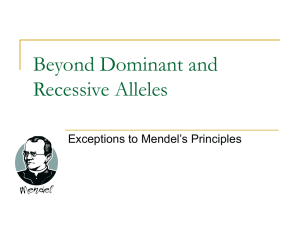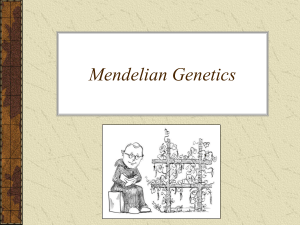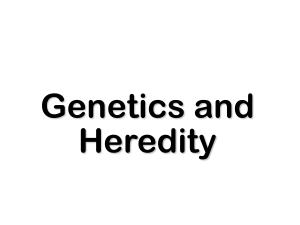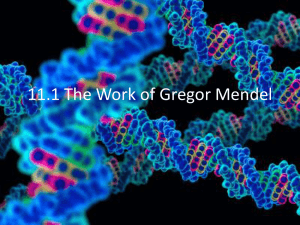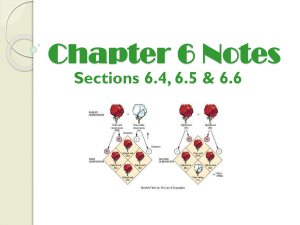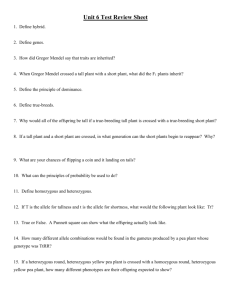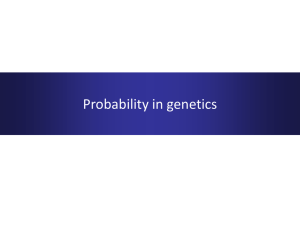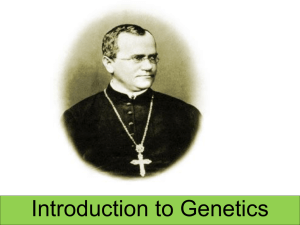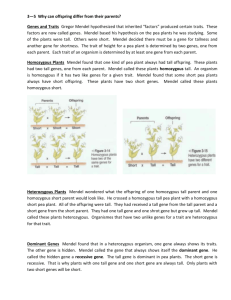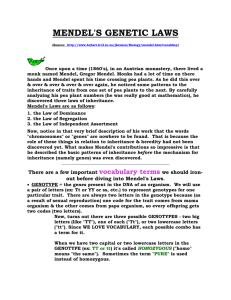Genetics - Mendel`s Laws of Heredity
advertisement
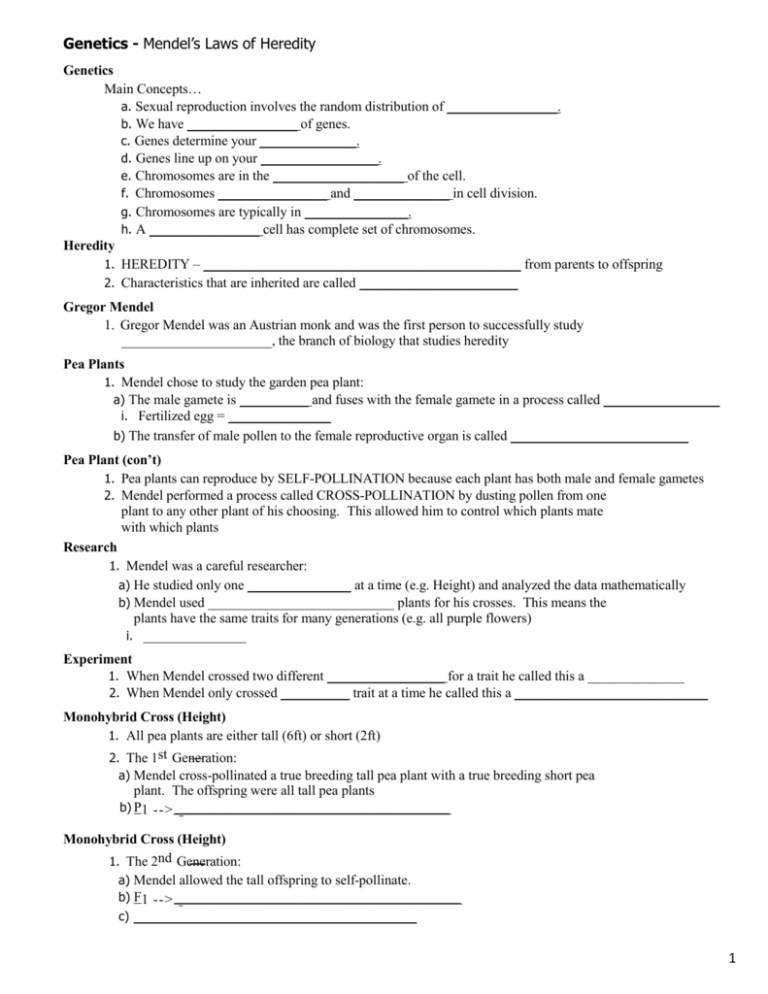
Genetics - Mendel’s Laws of Heredity Genetics Main Concepts… a. Sexual reproduction involves the random distribution of ________________. b. We have ________________ of genes. c. Genes determine your ______________. d. Genes line up on your _________________. e. Chromosomes are in the ___________________ of the cell. f. Chromosomes ________________ and ______________ in cell division. g. Chromosomes are typically in _______________. h. A ________________ cell has complete set of chromosomes. Heredity 1. HEREDITY – ______________________________________________ from parents to offspring 2. Characteristics that are inherited are called _______________________ Gregor Mendel 1. Gregor Mendel was an Austrian monk and was the first person to successfully study ______________________, the branch of biology that studies heredity Pea Plants 1. Mendel chose to study the garden pea plant: a) The male gamete is __________ and fuses with the female gamete in a process called _________________ i. Fertilized egg = _______________ b) The transfer of male pollen to the female reproductive organ is called __________________________ Pea Plant (con’t) 1. Pea plants can reproduce by SELF-POLLINATION because each plant has both male and female gametes 2. Mendel performed a process called CROSS-POLLINATION by dusting pollen from one plant to any other plant of his choosing. This allowed him to control which plants mate with which plants Research 1. Mendel was a careful researcher: a) He studied only one _______________ at a time (e.g. Height) and analyzed the data mathematically b) Mendel used ___________________________ plants for his crosses. This means the plants have the same traits for many generations (e.g. all purple flowers) i. _______________ Experiment 1. When Mendel crossed two different _________________ for a trait he called this a ______________ 2. When Mendel only crossed __________ trait at a time he called this a ____________________________ Monohybrid Cross (Height) 1. All pea plants are either tall (6ft) or short (2ft) 2. The 1st Generation: a) Mendel cross-pollinated a true breeding tall pea plant with a true breeding short pea plant. The offspring were all tall pea plants b) P1 --> __________________________________________________ Monohybrid Cross (Height) 1. The 2nd Generation: a) Mendel allowed the tall offspring to self-pollinate. b) F1 --> ____________________________________________________ c) _________________________________________ 1 Mendel’s Experiments Review Short pea plants X Tall pea plants Q: What did he get? A: ____________________________________________ Then, Tall X Tall pea plants Q: What did he get? A: ______________________________________________ ______________________________________________ Generations 1. The original (true breeding) parents are known as the P1 generation a) _____= “parent” 2. The offspring of the P1 generation are known as the F1 generation a) _____ = “filial” (son or daughter) 3. Crossing two F1 plants creates the F2 generation Conclusions from Mendel’s Experiments 1. Factors = ________________________ 2. Law of _______________: in any pair of genes, one may hide the appearance of the other. a) Dominant: ______________________ b) Recessive: masked, hidden, ________________________________ 3. Law of _______________________: the pairs of genes (and chromosomes) separate _________________! 4. Law of ______________________: During Meiosis chromosomes separate, and genes separate also. Rule of Dominance 1. Mendel also concluded that one allele is _________________ and one is ___________________ 2. The dominant allele is the one that shows up in the F1 generation (Tall) a) Capital letter -->T 3. The recessive allele is the trait that is hidden in the F1 generation (Short) a) Lowercase letter --> t 4. Capital letter is always written before the lowercase letter Dominant/Recessive Traits 1. A dominant trait (tall) is the result of either TT or Tt a) TT = tall b) Tt = tall 2. A recessive trait (short) can ONLY be the result of tt a) tt = short 3. The dominant allele always overrides the recessive allele, therefore, dominant traits are more common than recessive traits Alleles 1. Mendel concluded that each organism must have two factors that control each of its traits 2. We now know that traits are controlled by _____________ and are located on ____________________. 3. Genes exist in alternative forms called ________________________ a) Gene --> plant height i. Alleles --> tall or short ii. Alleles --> dominant or recessive Alleles 1. Alleles are located in exactly the same position on ___________________ chromosomes 2. In a diploid organism, there are ______________ alleles for a given gene 2 Genetics - Mendel’s Laws of Heredity a) One from ________________; one from ___________________ 3. A plant might have: a) 2 copies of the tall allele (TT) b) 2 copies of the short allele (tt) c) 1 tall and 1 short allele (Tt) Punnett Squares 1. Reginald Punnett devised an easy system to predict genotypic outcomes of a cross called a PUNNETT SQUARE 2. Parents gametes are combined in every possible combination 3. Monohybrid cross – one gene (height) 4. Dihybrid cross – two genes (height and color) Fractions, Percent, Ratios 1. Offspring outcomes can be expressed as: a) Fractions – ¼ or ¾ b) Percent – 25% or 50% or 75% c) Ratio – 3:1 or 1:2:1 Law of Segregation 1. The Law of Segregation – every individual has two alleles for each gene and each gamete receives one of these alleles The Law of Independent Assortment 1. The Law of Independent Assortment – genes for different traits are inherited independently of each other a) Height does not affect flower color; they are independent of each other b) Independent assortment results in increased _______________ because of the shuffling of individual genes Genotype vs. Phenotype 1. ______________________: physical appearance; what it looks like. a) EX. Green pea pod, pink flower, tall stems 2. _____________________: genetic make-up; combination of genes. 3. Represented by ______________________. 4. 3 possible genotypes. a) EX. GG, Gg, gg Homozygous vs. Heterozygous 1. Homozygous – two alleles are the _________________ a) Homozygous dominant -->TT b) Homozygous recessive -->tt c) True breeding (pure bred) 2. Heterozygous – two alleles are ____________________ a) Tt b) Hybrids Test Cross 1. A TEST CROSS is a cross of an individual of unknown genotype with an individual with a known genotype a) Test crosses use homozygous recessive individuals because the phenotype always indicates the genotype (short = tt) 2. Example: a) Tall pea plant: genotype unknown (TT or Tt) b) Short pea plant: known genotype (tt) c) Cross the tall plant with the homozygous recessive and look at the offspring i. If the offspring are all tall then the unknown genotype is TT 3 ii. If the offspring are 50% tall and 50% the unknown genotype is Tt 4
